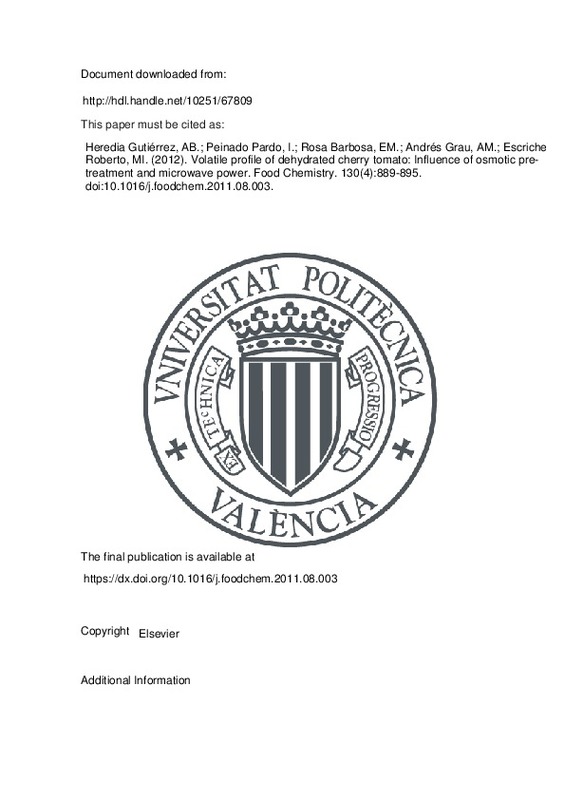JavaScript is disabled for your browser. Some features of this site may not work without it.
Buscar en RiuNet
Listar
Mi cuenta
Estadísticas
Ayuda RiuNet
Admin. UPV
Development of volatile fraction of fresh cut osmotically treated mango during cold storage
Mostrar el registro sencillo del ítem
Ficheros en el ítem
| dc.contributor.author | Torres Oquendo, Juan Diego
|
es_ES |
| dc.contributor.author | Chiralt, A.
|
es_ES |
| dc.contributor.author | Escriche Roberto, Mª Isabel
|
es_ES |
| dc.date.accessioned | 2017-01-19T12:50:56Z | |
| dc.date.available | 2017-01-19T12:50:56Z | |
| dc.date.issued | 2012-02-15 | |
| dc.identifier.issn | 0308-8146 | |
| dc.identifier.uri | http://hdl.handle.net/10251/77065 | |
| dc.description.abstract | [EN] The influence of minimal processing by osmotic treatment and cold storage on the volatile profile of mango was studied by comparison with the volatile profile of fresh samples. Osmotic treatments, at atmospheric pressure and by applying a vacuum pulse, were carried out using a 45 Brix sucrose solution with (2%) and without calcium lactate, at 30 °C. Samples were treated until they reached 20 Brix in all cases. The volatile profile of the samples was characterised at 0, 1, 4 and 8 days of cold storage at 10 °C, using purge and trap thermal desorption and GC-MS. Osmotic treatment provokes a decrease in the terpene concentration (the most abundant compounds in the volatile fraction mango) and an increase in ethyl acetate and 1-butanol. This fact was especially observed in treatment applying vacuum impregnation with calcium. Treatment at atmospheric pressure, with calcium in the osmotic solution, was the best way to prevent aroma alterations during processing and to ensure its stability throughout cold storage. © 2011 Elsevier Ltd. All rights reserved. | es_ES |
| dc.description.sponsorship | The authors thank Ministerio de Ciencia y Tecnologia (AGL2004-01009/ALI Project) for the financial support given to this research. | en_EN |
| dc.language | Inglés | es_ES |
| dc.publisher | Elsevier | es_ES |
| dc.relation.ispartof | Food Chemistry | es_ES |
| dc.rights | Reserva de todos los derechos | es_ES |
| dc.subject | GC-MS | es_ES |
| dc.subject | Mango | es_ES |
| dc.subject | Minimally processed fruit | es_ES |
| dc.subject | Osmotic dehydration | es_ES |
| dc.subject | Volatile compounds | es_ES |
| dc.subject | 1-butanol | es_ES |
| dc.subject | Calcium lactate | es_ES |
| dc.subject | Ethyl acetates | es_ES |
| dc.subject | Fresh-cut | es_ES |
| dc.subject | Minimal processing | es_ES |
| dc.subject | Osmotic solutions | es_ES |
| dc.subject | Osmotic treatment | es_ES |
| dc.subject | Purge and trap | es_ES |
| dc.subject | Sucrose solution | es_ES |
| dc.subject | Vacuum impregnation | es_ES |
| dc.subject | Vacuum pulse | es_ES |
| dc.subject | Volatile fractions | es_ES |
| dc.subject | Volatile profile | es_ES |
| dc.subject | Atmospheric pressure | es_ES |
| dc.subject | Calcium | es_ES |
| dc.subject | Cold storage | es_ES |
| dc.subject | Dehydration | es_ES |
| dc.subject | Olefins | es_ES |
| dc.subject | Sugar (sucrose) | es_ES |
| dc.subject | Thermal desorption | es_ES |
| dc.subject | Vacuum | es_ES |
| dc.subject | Volatile organic compounds | es_ES |
| dc.subject | Osmosis | es_ES |
| dc.subject | Sucrose | es_ES |
| dc.subject | Terpene | es_ES |
| dc.subject | Volatile agent | es_ES |
| dc.subject | Article | es_ES |
| dc.subject | Food processing | es_ES |
| dc.subject | Food storage | es_ES |
| dc.subject | Mass fragmentography | es_ES |
| dc.subject | Thermostability | es_ES |
| dc.subject.classification | TECNOLOGIA DE ALIMENTOS | es_ES |
| dc.title | Development of volatile fraction of fresh cut osmotically treated mango during cold storage | es_ES |
| dc.type | Artículo | es_ES |
| dc.identifier.doi | 10.1016/j.foodchem.2011.08.012 | |
| dc.relation.projectID | info:eu-repo/grantAgreement/MEC//AGL2004-01009/ES/APLICACION DE RECUBRIMIENTOS COMESTIBLES EN LA OPTIMIZACION DE LA CALIDAD Y SEGURIDAD DE FRUTAS MINIMAMENTE PROCESADAS/ | es_ES |
| dc.rights.accessRights | Cerrado | es_ES |
| dc.contributor.affiliation | Universitat Politècnica de València. Departamento de Tecnología de Alimentos - Departament de Tecnologia d'Aliments | es_ES |
| dc.description.bibliographicCitation | Torres Oquendo, JD.; Chiralt, A.; Escriche Roberto, MI. (2012). Development of volatile fraction of fresh cut osmotically treated mango during cold storage. Food Chemistry. 130(4):921-927. https://doi.org/10.1016/j.foodchem.2011.08.012 | es_ES |
| dc.description.accrualMethod | S | es_ES |
| dc.relation.publisherversion | https://dx.doi.org/10.1016/j.foodchem.2011.08.012 | es_ES |
| dc.description.upvformatpinicio | 921 | es_ES |
| dc.description.upvformatpfin | 927 | es_ES |
| dc.type.version | info:eu-repo/semantics/publishedVersion | es_ES |
| dc.description.volume | 130 | es_ES |
| dc.description.issue | 4 | es_ES |
| dc.relation.senia | 206314 | es_ES |
| dc.contributor.funder | Ministerio de Educación y Ciencia |






![[Cerrado]](/themes/UPV/images/candado.png)



